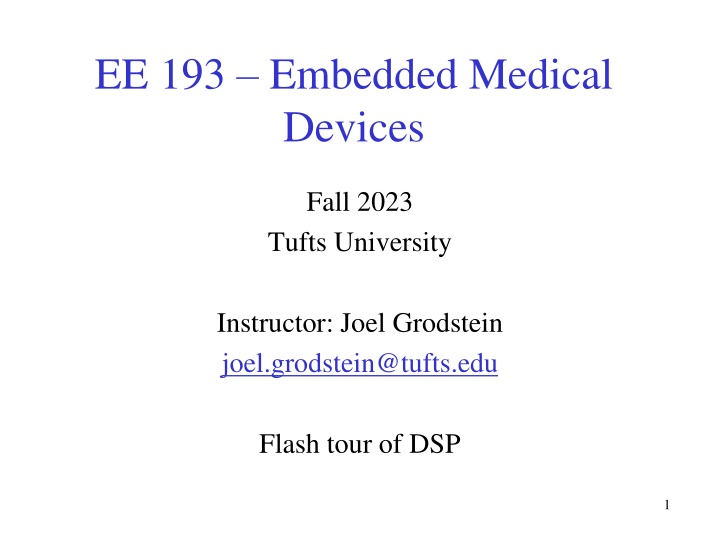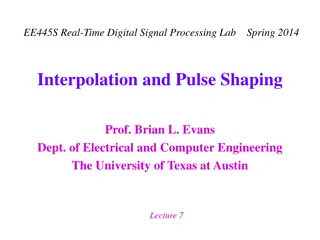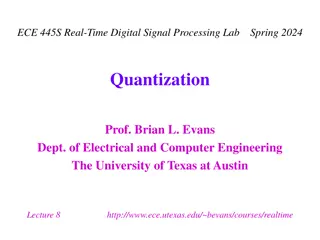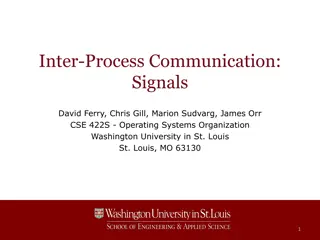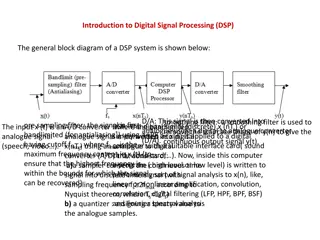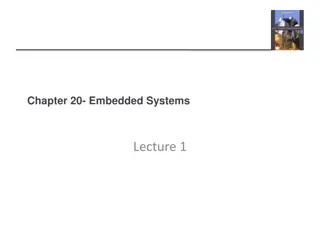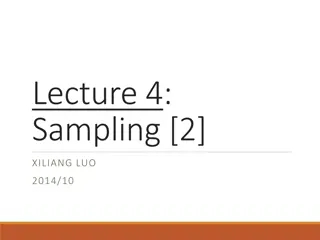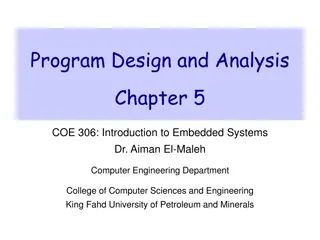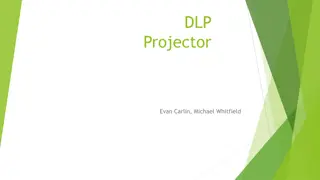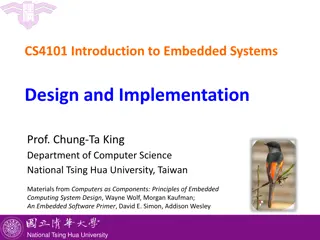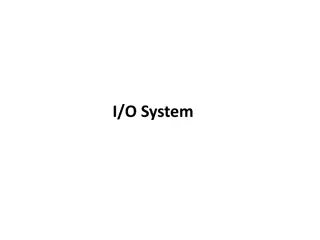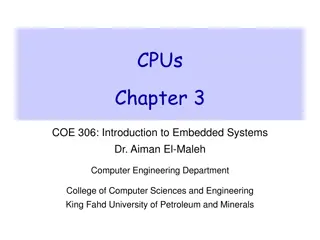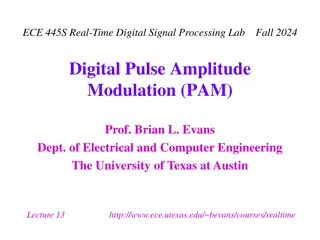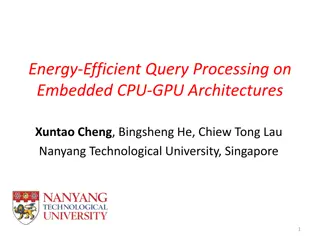Introduction to Digital Signal Processing for Embedded Medical Devices
Join Joel Grodstein in the Fall 2023 session of EE.193 at Tufts University for a flash tour of DSP. Explore why DSP is essential for embedded medical devices, learn about noise sources, and discover how filters can enhance signal quality. Engage in in-class exercises to practice noise frequency measurement and understand the significance of the frequency domain in filtering processes. Delve into the world of DSP to clean up noisy environments and optimize embedded systems.
Download Presentation

Please find below an Image/Link to download the presentation.
The content on the website is provided AS IS for your information and personal use only. It may not be sold, licensed, or shared on other websites without obtaining consent from the author.If you encounter any issues during the download, it is possible that the publisher has removed the file from their server.
You are allowed to download the files provided on this website for personal or commercial use, subject to the condition that they are used lawfully. All files are the property of their respective owners.
The content on the website is provided AS IS for your information and personal use only. It may not be sold, licensed, or shared on other websites without obtaining consent from the author.
E N D
Presentation Transcript
EE 193 Embedded Medical Devices Fall 2023 Tufts University Instructor: Joel Grodstein joel.grodstein@tufts.edu Flash tour of DSP 1
What well cover Main topics: Why do we care about DSP The frequency domain Building DSP filters Cascading DSP filters EE 193 Joel Grodstein 2
Why learn about DSP? Today s lecture: digital signal processing (DSP) The usual question: why do we care? What does DSP have to do with embedded medical devices? Answer: the world is a noisy place! The signals we read typically have a low signal-to- noise ratio DSP can often remove the noise without losing the signal What are some noise sources? EE 193 Joel Grodstein 3
Show my ECG sitting at a desk: slide_4() In-class exercise: measure the noise frequency Any idea what the noise is? Goal: keep the baby, throw away the bathwater Only possible if you can tell one from the other! Often frequency is the distinguishing factor If so, a filter can keep the signal, remove the noise EE 193 Joel Grodstein 4
DSP is great! Throwing away the bathwater is magic EE 125 is a full semester DSP course Today s lecture, rephrased Many embedded systems live in noisy environments Learn just enough DSP to clean them up And maybe convince you to take EE/ME 125 Some short videos https://www.youtube.com/watch?v=spUNpyF58BY https://www.jezzamon.com/fourier EE 193 Joel Grodstein 5
What well cover Main topics: Why do we care about DSP The frequency domain Building DSP filters Cascading DSP filters EE 193 Joel Grodstein 6
The frequency domain Most filters are best understood in the frequency domain: e.g., remove the 60 Hz noise What does a frequency domain representation of a signal even mean? Covered in BME 10, ME 31, EE 20-23 We ll review a bit right now EE 193 Joel Grodstein 7
Do my 10 and 15 Hz example: slide_8() Play with the weighting factors to pick just 10Hz, just 15 Hz, and weightings We see the analog sum and the DFT Conclusion With weighted sum, it s not obvious from the time plot what the coefficients are! But it s very obvious from the DFT EE 193 Joel Grodstein 8
Arbitrary signals Ifyour signal is just the sum of a few sine waves then a frequency domain representation makes sense But what if you have an arbitrary signal? What does a frequency-domain representation mean? EE 193 Joel Grodstein 9
DFT of an ECG Discrete Fourier Transform = DFT Amazing fact: you can express any signal as weighted sum of sine waves! Let s take the DFT of an ECG: slide_10() Observations about the frequency spectrum? When we take the inverse DFT, it restores the original signal! Is there something deep about that? EE 193 Joel Grodstein 10
Filtering with a DFT Easy trick: we can fix our noisy ECG Take the DFT Then just zero out the 60Hz component! slide_11() Does the noise problem look fixed? Class exercise Does it look like there s some 60Hz component to the hypothetical noise-free ECG? If so, is that a problem? EE 193 Joel Grodstein 11
On-the-fly filtering Next problem We can t take the DFT of the signal until we have the whole signal; but we really want on the fly beat-by-beat processing Look at the code for slide_11() to see that The way to do that is with digital filters EE 193 Joel Grodstein 12
Skip to the fun part Time for a skip all the hard stuff alert Skipping Z transforms (DSP version of Fourier transforms) Correspondence between Z transform & difference equations Going straight to using Python to design digital filters sticking them into our embedded C program EE 193 Joel Grodstein 13
Summary so far What have we learned You can take any waveform express it as the sum of sine waves with a DFT zero out any frequencies we don t want re-sum the sine waves to get a cleaner signal Only useful if your noise is at a different frequency than your signal EE 193 Joel Grodstein 14
What well cover Main topics: Why do we care about DSP The frequency domain Building DSP filters Cascading DSP filters EE 193 Joel Grodstein 15
Bandstop filters A bandstop filter passes all frequencies except for a small band We ll build a 60Hz bandstop filter slide_16() How are the results? How does this filter shape compare to our kill-the- 60Hz-band filter? EE 193 Joel Grodstein 16
Second-order section y[n] = b0x[n] + b1x[n-1] + b2x[n-2] - a1y[n-1] - a2y[n-2] filter output current input sample x[n] y[n] b0 delay delay b1 weighted sum x[n-1] y[n-1] delay delay b2 x[n-2] y[n-2] previous filter outputs previous input samples EE 193 Joel Grodstein 17
Code Look at the Pan-Tompkins code for a single biquad (biquad = second-order section) x[n] y[n] b0 delay delay b1 weighted sum x[n-1] y[n-1] delay delay b2 x[n-2] y[n-2] EE 193 Joel Grodstein 18
What well cover Main topics: Why do we care about DSP The frequency domain Building DSP filters Cascading DSP filters EE 193 Joel Grodstein 19
More poles We ve used a single second-order section DSP-speak is that we built a two-pole filter Slide_20() shows a four-pole filter implemented as two cascaded second-order sections EE 193 Joel Grodstein 20
Four-pole implementation Cascading second-order sections is easy x[n] y[n] delay delay weighted sum delay delay x[n] y[n] delay delay weighted sum delay delay EE 193 Joel Grodstein 21
2 vs. 4 poles? More poles equals better rejection of the unwanted signal slower software and more distortion No free lunch! EE 193 Joel Grodstein 22
2 vs. 4 poles? Four poles is slower does it practically matter? Exercise: compute how fast CPU = 80 MHz, say 1 instruction every 2 cycles float xn = (float)sample / (float)( 1 << samplebits ); float yn = co->b0*xn + co->b1*state->x_nm1 + co->b2*state->x_nm2 - co->a1*state->y_nm1 - co->a2*state->y_nm2; state->x_nm2 = state->x_nm1; state->x_nm1 = xn; state->y_nm2 = state->y_nm1; state->y_nm1 = yn; EE 193 Joel Grodstein 23
Cascading filters A four-pole filter didn t help us much But cascading filters of different types can be quite effective What problems did we see after the 60Hz noise was removed? Some 180Hz and 300Hz noise Any obvious ideas for how to fix that? Cascade a 60Hz bandstop with 180Hz and 300Hz bandstops EE 193 Joel Grodstein 24
Baseline drift slide_25() shows a baseline drift signal Typical causes breathing or other slow, rhythmic body movement electrode movement Remove it with a high-pass filter How much did that help? Any idea why? EE 193 Joel Grodstein 25
Types of filters Bandstop: kill a band of frequencies Bandpass: pass a band of frequencies Low-pass: keep all frequencies below f0 High-pass: keep all frequencies above f0 Can you think of uses for each filter type? EE 193 Joel Grodstein 26
Two AD8232 boards AD8232 chip is a bio preamp Made by Analog Devices Aimed at commercial ECG market Add a few R, C add a bandpass filter We use a Sparkfun AD8232 board Built-in .5-40Hz bandpass filter Targeted at hobbyists Cardiologists want signal up to 150 Hz Wideband Sparkfun boards pass .5-150Hz EE 193 Joel Grodstein 27
